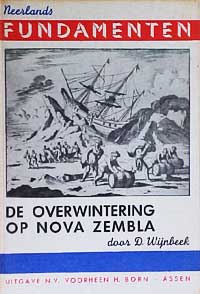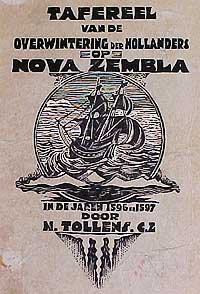

The myth of Novaya Zemlya
In the 19th century, the myth was further propelled into the mainstream of Dutch historical conciousness by poets such as #Hendrik Tollens, who used the experiences of Barentsz and Van Heemskerck in order to appeal to the patriotic sentiments and nationalistic fervour typical for this period.
Subsequently, many (children's) books appeared on the wintering at Novaya Zemlya, often only loosely based on De Veer's report. In times of hardship in particular, such as during and immediately after World War II, the story of 'national heroism' resurfaced, in order to emphasize 'typically Dutch virtues' like courage, persistence, and a free spirit of inquisitiveness. The two examples below were both products of the 1940s:
Illustration 16. Neerlands fundamenten. De overwintering op Nova Zembla was published in 1941, when The Netherlands were occupied by Nazi Germany. The colours of the Dutch flag on the title-page - red, white, and blue - immediately catch the eye. The book was in all likelihood designed to remind the reading public of the suffering of earlier generations of Dutchmen. |
 |
|
|
These examples of 20th century interpretations of the Novaya Zemlya expedition complete this study-pack. To check your understanding of the material presented here, try to >answer the questions in our quiz.


